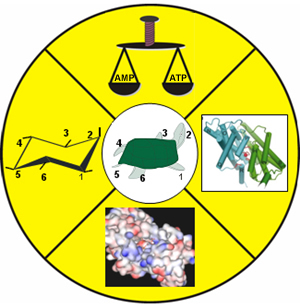 |
|
Intracellular Signals Stephen B. Shears, Ph.D.
Principal Investigator Tel (919) 541-0793 Fax (919) 541-1898 shears@niehs.nih.gov P.O. Box 12233 Mail Drop F2-06 Research Triangle Park, North Carolina 27709 Delivery Instructions Research SummaryAn extracellular stimulus, a hormone for example, evokes a specific response from its target cell, such as the release or accumulation of nutrient, the secretion of salt and fluid, or the initiation of muscle contraction. In order to ensure that the cellular response is appropriate, the information that is conveyed by the original stimulus typically causes specific changes in the levels of biologically‑active, intracellular signals, or "second messengers." This whole process--signal transduction--is fundamental to how an organism responds and adapts to changes in the environment. The Inositol Signaling Group studies a group of intracellular signals known as the inositol phosphates. These compounds play a number of important "second messenger" roles. 
A diagrammatic representation of the ongoing research projects that occur in the Inositol Signaling Group.
This group’s particular strength lies in its technological specialization and conceptual advances that have provided insight into the roles of the most highly phosphorylated inositol phosphates, i.e., InsP4, InsP5, and InsP6, and especially the diphosphorylated derivatives (InsP7 and InsP8). A multidisciplinary approach is taken, utilizing techniques from the fields of biochemistry, molecular biology, cell biology, structural biology, electrophysiology and synthetic chemistry. Group scientists clarify the physiological actions of inositol phosphates by studying the enzymes that control their intracellular levels and hence their signaling strength, and also by characterizing the biologically important changes in cellular function that are mediated by the inositol phosphates. The group’s work is directly relevant to improving human health. In some situations, the inositol phosphates play important roles in helping cells adapt to certain environmental insults, toxins, and bacterial and viral infections or genetic defects. In other situations it is the inositol phosphate signaling processes themselves that are perturbed by these external agents. The adequate treatment of such disturbances requires an understanding of the precise molecular mechanisms that are involved. One project centers on the contributions that InsP7 and InsP8 make in regulating cellular responses to a range of environmental stresses, including thermal shock, heat stress and the energy stress that results when cellular concentrations of ATP and AMP become unbalanced. The group also studies the regulation by InsP4 of the conductance of a group of chloride‑conducting ion channels in the plasma membrane. It is the participation of these ion channels in the process of salt and fluid secretion from cells lining the airways that has provided the major physiological end‑point for the studies. This work is relevant to improving therapy for cystic fibrosis, asthma and chronic bronchitis. Nevertheless, these ion channels have other functions; they contribute to cellular and subcellular pH balance, cardiac function, neurotransmission, osmoregulation and smooth muscle contraction. Major areas of research:
Current projects:
Stephen B. Shears, Ph.D., heads the Inositol Signaling Group within the Laboratory of Signal Transduction. He received his Ph.D. in 1979 from the University of York in the U.K. He has published over 150 peer-reviewed articles in leading biomedical journals, as well as several book chapters. |
|

